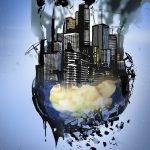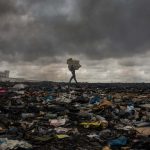The earth’s wealth generates humankind’s poverty
Brazilian President Jair Bolsonaro has gutted most environmental protections in favour of capitalist interests including mining and agriculture, further devastating the Amazon.
Author:
9 April 2019

In Open Veins of Latin America (1971) Eduardo Galeano wrote, “Our wealth has always generated our poverty by nourishing the prosperity of others.” Galeano’s book lyrically details Latin America’s long history, from its colonisation to the era of military coups of the 1970s. In this long period, the wealth of the continent was stolen to benefit imperial powers elsewhere (in Europe and in North America) as well as local oligarchs. The people and land were leached of their wealth. Forests, rivers, soil and subsoil – all were converted from their natural state into raw material for capitalist accumulation. The more the resources, the more the pillage and the poorer the people.
In the midst of the continent is the vast Amazon, the world’s largest tropical rainforest. The Amazon is the main bio-genetic reserve for the planet and in it sits enormous mineral resources. If you destroy the Amazon, you destroy the planet. To plunder the Amazon is the road to planetary destruction.
The national context
The current Brazilian context is shaped by uncertainty – including uncertainty of labour and social rights. But what is certain is that the entire political process from before the 2018 elections had been driven to a large extent by the fight over the Amazon. The national and international elites attached to the agribusiness and mining sectors had a pioneer role in the soft coup process made up of the impeachment of President Dilma Rousseff, the persecution of President Lula, and the election of President Jair Bolsonaro in October 2018.
When Jair Bolsonaro ran for the presidency in 2018, he spoke openly on behalf of agribusiness and mining, including his intention to roll back regulations and open the Amazon to business interests. He said he would hand over indigenous lands, quilombola territories and conserved land to agribusiness and landowners for exploration and exploitation. They revelled in his commitment to eradicate the landless movements and to abolish environmental regulations (including the overuse of pesticides). He said he would give priority to the infrastructural projects and the financing needs of these business sectors.
Related article:
Bolsonaro united the interests of various fractions of Brazil’s national bourgeoisie with the interests of international capital (notably, with the imperialist bloc, with the emerging neofascist bloc and with financial capital). Their goals are clear: (1) Defeat the Brazilian working-class and deploy brutal forms of labour exploitation. (2) Plunder the commonly held goods of the people, such as oil, gold, water and land, as well as to curtail Brazil’s biodiversity. The state would facilitate the rentier dynamics of the national bourgeoise and provide the platform for transnational capital to accumulate at will. (3) Appropriate the social wealth held in public funds, in state-owned companies and in the public sector (health and education). There is a direct policy to privatise public wealth and subordinate these institutions to transnational finance capital. (4) Realign Brazil’s foreign policy orientation, from one of being pledged to multi-polarity to one that is subordinate to the interests of the United States.
Bolsonaro’s presidency has engineered many shifts related to environmental issues, some cleverly disguised and others patently obvious. Bolsonaro wanted to abolish the Ministry of the Environment, but that would have been very provocative. Instead, he restructured the ministry to gut it of its enforcement ability. Many of the functions of the ministry have been eliminated, others suspended and yet others reassigned to other ministries. The point is to render such ministries ineffective. That is what the government has been doing.
The head of the Ministry of the Environment is Ricardo Salles, the founder of a movement to “straighten Brazil” (Movimento Endireita Brasil). In Salles’ view, straightening Brazil means to liberate business interests from regulations on labour and environment exploitation. Since 2017, Salles has faced a civil action for the violation of environmental laws to damage the Tietê River protected area.
Large Amazon and the projects of predatory exploitation
The exploitation of the Amazon follows clearly the pattern of what is known as neo-extractivism. This is a concept that describes the removal of large volumes of natural resources from a country before they are processed into more refined materials or goods. The raw materials are destined for export, with little advantage to the country that produced them.
This technological gap – where the wealth of natural resources is drained from countries like Brazil in the tricontinent to the Global North – is a continuation of a long history in which the wealth of Latin America “has always generated our poverty by nourishing the prosperity of others”, as Galeano would say. The country that holds the wealth is forced to forfeit it to its former coloniser who holds a near-monopoly over the technological capacity to produce and refine these resources. Having been forced to forfeit this part of the production process, the former colonies are left with no choice but to purchase the final products at much higher costs.
Related article:
The country of raw materials is left dependent on the world market. It can do nothing else but sell its raw materials and then use that money to import goods at much higher prices. Earlier exploitation in the Amazon was for rubber, which was tapped to satisfy the ravenous hunger of the industrial revolution. The Brazilian state provided a platform for transnational firms to take advantage of the resources. Large numbers of people from Brazil’s Northeast were displaced into the Amazon to become the labour force for the exploitation of the rubber trees. When US control over rubber plantations in Asia satisfied world demand, the Amazon’s trees and workers were forgotten. Brazil did not control the market and was utterly subordinate to the transnational firms.
After the 1964 civil-military coup, the dictatorship occupied the whole territory of the Amazon in the name of the defence of national sovereignty. The real goal, however, was to contain the workers and to seize the land so as to set in motion a new environment for the exploitation of the Amazon. It was seen as the “frontier of natural resources”, which were delivered to transnational corporations once more. These conglomerates have increased their power over the years.
Plunder
Knowledge, developed by indigenous people over thousands of years, is part of what transnational firms have long coveted. This was clear with plants that become medicines, patented in Europe to be sold for massive profits. In the 19th century, England removed 70 000 rubber tree seeds from the Amazon – without any payment to the indigenous communities that had developed them – and replanted them in Malaysian rubber plantations. Generations of knowledge and traditions were stolen and made into firm-owned intellectual property.
In the 1990s, the Brazilian state’s sovereignty over its subsoil and its goods as well as the approval of international patent laws meant that the country could no longer preserve its own technologies and had to pay for technology patented by a firm elsewhere. The common knowledge of the Amazonian people began to be privatised and transnational firms began to patent the active substances of Amazonian plants. This was biopiracy, plunder of the common knowledge of the Amazon.
All mining requires enormous amounts of water. Water is needed to transform bauxite into primary aluminium, to produce livestock and to generate energy through the construction of hydroelectric plants. The Amazon has 20% of the planet’s accessible freshwater. This water was handed over to the transnational firms at very low rates. Meanwhile, only half of the households in the Amazon have piped water and less than five percent have sewage systems. Water was plundered by the firms, as rivers were destroyed for them. No longer does the Amazon look like it did a hundred years ago.
Social and political conflicts
No attack on the Amazon by the Brazilian state and the transnational firms will go unchallenged. Popular struggles to defend the right to land and fair labour laws, as well as to preserve the culture and organisation of the people who live in the Amazon, are ongoing. These struggles preserve old rights. But they also imagine a different society, one in which land and its habitants are respected and development is equally valued. Land must be fairly allocated, and the environment must not be plundered.
These struggles are not new. The fight to protect the land and the forests is an old one and one with brutal consequences. It was in this context that two important leaders were assassinated – Wilson Pinheiro, president of the rural workers’ union (1980), and Chico Mendes, president of the rural workers’ union of Xapuri (1988). Over the years, these killings have continued. In 1996, 19 landless workers of the Movimento dos Trabalhadores Rurais Sem Terra (MST) were killed in Eldorado dos Carajás. In 2005, the American missionary Dorothy Stang, who organised amongst workers resisting the loggers, was killed. José Claudio Silva, Maria do Espírito Santo da Silva, and many others were also killed when they challenged deforestation and land theft. Since the 2016 coup, the murder of peasant leaders has accelerated.
In 2003, the first year of the Lula administration, 73 peasants were murdered. From 2003 to 2015, murders continued in alarming numbers – between 25 and 39 leaders murdered in this period by the agribusiness forces. But then the numbers increased even more dramatically – 50 murders in 2015, 61 in 2016 and then 70 in 2017.
Challenges
The destruction of the Amazon is irreversible.
The model that is leading to the death of the Amazon needs to be buried underground. It is the model of predatory development, the benefit of which goes to the very few at the expense of the many. When the planet is destroyed, even the very few will not be its beneficiaries.
Another model, which serves the collective interests of society and nature, is necessary. This model is one built by the resistance of people’s struggles – by the landless, by indigenous groups, by quilombolas and Afro Brazilians, and all who have been wrung dry by a neo-extractivist model that, like a leach, sucks the resources from the earth and the vast majority of its inhabitants. It is our mandate to dream of a world that is not just formed in opposition to the problems we face, but that dares to dream of a future that values the earth, its flora and fauna, and its people.
Related article:
In this world, indigenous knowledge of plants in the Amazon is used for medicines for the general public, rather than to further the wealth of the few through intellectual property rights. In this world, people have a right to the land that they have lived on for hundreds to thousands of years, and to the resources that surround them. They have the right to food sovereignty – to produce and consume nourishing food that they themselves produce, rather than be beholden to endless fields of soya that they will never consume and subjected to agrotoxins that make them sick.
Towards that end then, our struggle moves.
This is an edited excerpt of the Tricontinental: Institute for Social Research’s publication Dossier 14 Brazil’s Amazon: The Wealth of the Earth Generates the Poverty of Humankind (March 2019).



